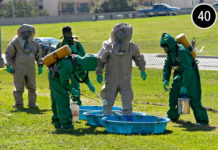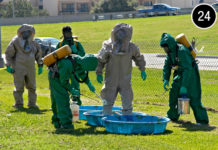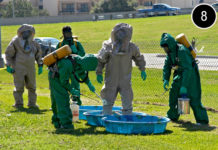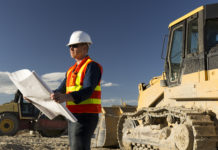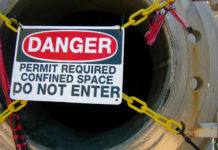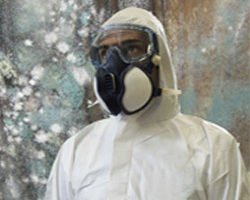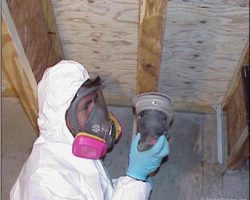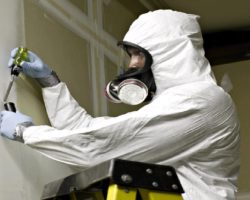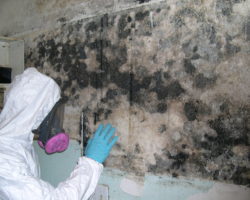Mold inspections are performed by a certified mold inspector who has formal training and experience with mold inspections. A Certified Mold Inspector (CMI) is a specialist who has been professionally trained to assess both the presence of microbial contamination, and the source of any underlying moisture intrusion.
The National Association of Mold Professionals (NAMP) is a non-profit organization that was established with the goal of developing and promoting the Mold Inspection and Remediation industry. NAMP Certified Mold Inspectors and Remediators consistently earn the highest income in the industry.
The Mold Inspector – NAMP Certification Course is America’s oldest and most respected certification course and provides education and authoritative credentials for Mold Professionals. NAMP Certified Mold Inspectors and Remediators consistently earn the highest income in the industry.
The NAMP Mold Inspection and Remediation course has been approved for the following:
- National Association of Home Inspectors (NAHI)
- The Institute of Inspection, Cleaning & Restoration Certification (IICRC)
- ASHI® – 2 Membership Renewal Credits
- The National Association of Certified Home Inspectors (NACHI)
- State of Louisiana Mold Remediation Licensing
Mold Inspector Certification (NAMP)
Course Overview
The Mold Inspector Certification – NAMP Certified Mold Inspector Course – provides an overview of the impact of mold on our environment and of the principles and procedures involved in the inspection, testing, abatement and management of molds.
This course will provide the learner with a fundamental knowledge about fungi, the potential health risks of toxigenic mold, and the different ways to inspect for and control mold infestation, while ensuring your safety during the process.
This course will also explain the different tools and personal protective equipment (PPE) used during the inspection process. For each area of a house or building, in detail what to inspect, how to access it, and the sampling methods to use if mold is indicated.
Finally, the course will explain the testing procedures and legal requirements used by an AIHA certified laboratory. Last, you will learn how to interpret the results of laboratory testing.
Newly updated! Fully interactive training written by industry experts!
Hours: 6 hours
Pre-Requisites: None
Intended Audience
This training is intended for anyone who comes into contact with mold may benefit from our course. These individuals include home inspectors, builders, remodelers, plumbers, electricians, HVAC contractors, pest control contractors, carpet cleaners, fire, flood and water restoration contractors, house designers, architects and engineers.
Learning Objectives
Successful completion of this course will enable you to professionally inspect for mold in each area of a building or house and sample, test, and interpret mold lab results. At the conclusion of this course, you will be able to:
- Identify the services the NAMP Certified Mold Inspector provides.
- Discuss the characteristics and health impact of Fungi and the criteria that indicate toxigenic mold.
- Describe the ways to control mold.
- Identify the tools and personal protective equipment used to detect mold.
- Identify the areas and methods used to inspect in the exterior and interior of building assemblies, including foundations, roofing, basements, crawlspaces, attics, and interior rooms.
- List mold testing procedures and legal requirements.
- Explain the interpretation of laboratory results.
Subject Matter Expert
This course was produced in partnership with the NAMP – National Association of Mold Professionals.
Dr. Edward P. Malone, M.S., CMI, CMR assisted as this subject matter expert.
For the last 20 years Mr. Maloney has focused exclusively on mold research, detection and remediation. Mr. Maloney is a director of the National Association of Mold Professionals and has taught over 70 courses on Mold Inspection, Testing and Remediation.
Module Quizzes and Final Exam
All module quizzes require a score of 70% to proceed forward in the course. The exam will test your knowledge on information covered throughout the course. You must make a score of at least 70% to pass this course. You will be given up to three opportunities to pass each quiz and the final exam. If you do not pass after three tries, you will be locked out of this course will no longer be able to take your Outreach training in an online format.
Course Completion Certificate
Upon successful completion of the course, you will receive a printable certificate of completion which is accepted by OSHA as documentation of training.
Industry Terms
- certified mold inspectors
- certified mold remediator
- certified mold worker
- certified indoor air quality professional
- Indoor Air Quality Association (IAQA)
- Indoor Environmental Standards Organization (IESO)
- American Indoor Air Quality Council (AmIAQ)
- Mold Inspector Certification
- NAMP mold inspector training
- certified mold inspection course
- certified mold inspector training
- epa mold inspector certification
Introduction to Molds
Molds produce and release millions of spores small enough to be air-, water-, or insect-borne. They can also produce toxic agents known as mycotoxins. Spores and mycotoxins can have negative effects on human health.
For those people who are affected by mold exposures there can be a wide variation in how they react. People at greatest risk of health effects are individuals with allergies, asthma, sinusitis, or other respiratory conditions, as well as infants and children, elderly people, and pregnant women. In addition, individuals with a weakened immune system are at risk.
Reference: Occupational Safety & Health Administration (OSHA) – Molds
EPA Training – Mold Course
Introduction to Mold and Mold Remediation for Environmental and Public Health Professionals (PDF). Environmental Protection Agency (EPA) Mold Web Course. Gives specific recommendations for personal protective equipment (PPE) when cleaning mold.
- Mold Course Chapter 1: Introduction to Molds
- Mold Course Chapter 2: Why and Where Mold Grows
- Mold Course Chapter 3: Finding Mold and Moisture
- Mold Course Chapter 4: General Remediation Issues
- Mold Course Chapter 5: Large Areas and Other Special Concerns
- Mold Course Chapter 6: Containment and Personal Protective Equipment (PPE)
- Mold Course Chapter 7: Evaluating the Remediation
- Mold Course Chapter 8: Communicating with the Building Occupants
- Mold Course Chapter 9: Prevention
Also available:
OSHA Resources and References
- Bardana, E. Indoor air quality and health: Does fungal contamination play a significant role? Immunological and Allergy Clin N Am. (23) 2003: 291-309
- 29 CFR 1910.134, Respiratory protection. OSHA Standard.
- A Brief Guide to Mold in the Workplace. OSHA Safety and Health Information Bulletin (SHIB), (2003).
- Fungi Hazards and Flood Cleanup [3 KB PDF*, 2 pages]. OSHA Fact Sheet, (2005).
- Mold [22 KB PDF*, 2 pages]. OSHA Fact Sheet, (2005).
- Mold. OSHA Safety and Health Topics Page.
- Storm/Flood and Hurricane Response. National Institute for Occupational Safety and Health (NIOSH) Workplace Safety and Health Topic.
- Mold Prevention Strategies and Possible Health Effects in the Aftermath of Hurricanes and Major Floods. Centers for Disease Control and Prevention (CDC), (2006). (Also available in: Mortality and Morbidity Weekly Report, June 9, 2006/55(RR08);1-27)
- Guidelines for the Protection and Training of Workers Engaged in Maintenance and Remediation Work Associated with Mold [448 KB PDF, 43 pages]. National Clearinghouse for Worker Safety and Health Training, (2005).
- Mold Remediation in Schools and Commercial Buildings. Environmental Protection Agency (EPA), (2001, March).
- Guidelines on Assessment and Remediation of Fungi in Indoor Environments [71 KB PDF, 25 pages]. New York City Department of Health and Mental Hygiene, (2008).
- Respirator Selection Logic 2004. Centers for Disease Control and Prevention (CDC), (2004, October).
National Environmental Policy Act (NEPA)
The National Environmental Policy Act (NEPA) is a United States environmental law that established a U.S. national policy promoting the enhancement of the environment and also established the President’s Council on Environmental Quality (CEQ). The essential purpose of NEPA is to ensure that environmental factors are weighted equally when compared to other factors in the decision making process undertaken by federal agencies.
National Institute for Occupational Safety and Health (NIOSH)
DHHS (NIOSH) Publication Number 2013-102
NIOSH Alert: Preventing Occupational Respiratory Disease from Exposures Caused by Dampness in Office Buildings, Schools, and Other Nonindustrial Buildings
The guidance includes a building inspection checklist and may be of interest to people working in office buildings, schools and other nonindustrial buildings.
Reference: http://www.cdc.gov/niosh/docs/2013-102/
EPA Compliance Regulations
- CAA – Clean Air Act http://www.epa.gov/air/caa
- CWA – Clean Water Act http://www.epa.gov/regulations/laws/cwa.html
- RCRA – Resource Conservation & Recovery Act http://www.epa.gov/regulations/laws/rcra.html
- EPCRA – Emergency Planning & Community Right-to-Know http://www.epa.gov/osweroe1/content/epcra
- TSCA – Toxic Substance Control Act http://www.epa.gov/lawsregs/laws/tsca.html
- CERCLA – Comprehensive Environmental Response Compensation & Liability Act http://www.epa.gov/superfund/policy/cercla.htm
- IICRC – Institute of Inspection, Cleaning & Restoration Certifications http://www.iicrc.org/what-does-certified-mold-inspector-training-offer-a-33.html
NAMP Standards for Conduct and Ethics
To promote and protect the Mold Detection and Remediation Industry, and members of the National Association of Mold Professionals, NAMP has developed the following Standards for Conduct and Ethics to be followed by its members:
- The Mold Professional shall uphold the honor and dignity of this profession and avoid association with any enterprise of questionable character or apparent conflict of interest.
- The Mold Professional shall protect and promote the interests of the client to the best of the Mold Professional’s ability and knowledge, recognizing that the client has placed its trust and confidence in the Mold Professional.
- The Mold Professional shall always endeavor to maintain and increase his/her level of knowledge regarding new developments in the field.
- The Mold Professional shall conduct his/her business in a manner that will assure the client of the Mold Professional’s independence from outside influence and interest, which would compromise the Mold Professional’s ability to render a fair and impartial opinion, regarding any inspection performed.
- The Mold Professional shall not accept compensation from more than one interested party for the same service on the same property without the consent of all interested parties.
- The Mold Professional shall promptly disclose to the client any interest in any other business which may effect the client, the quality, or the result of the inspection or remediation.
- The Mold Professional shall not knowingly use the inspection or remediation process to obtain work in another field.
- The Mold Professional shall make every effort to uphold, maintain and improve the professional practice, integrity and reputation of The National Association of Mold Professionals.
Mold Glossary of Terms
- Air Handling Unit: Equipment that includes a blower or fan, heating and/or cooling coils, and related equipment such as controls, condensate drain pans, and air filters. Does not include ductwork, registers or grilles, or boilers and chillers. Acronym: AHU
- Allergen: A substance, such as mold, that can cause an allergic reaction.
- Antimicrobial: Agent that kills microbial growth (i.e., chemical or substance that kills mold or other organisms). See “Biocide” and “Fungicide.”
- Biocide: A substance or chemical that kills organisms such as mold.
- Biological Contaminants: 1) Living organisms, such as viruses, bacteria, or mold (fungi), 2) the remains of living organisms, or 3) debris from or pieces of dead organisms. Biological contaminants can be small enough to be inhaled, and may cause many types of health effects including allergic reactions and respiratory disorders.
- Building Envelope: Elements of the building, including all external building materials, windows, and walls, that enclose the internal space.
- Ceiling Plenum: Space between a suspended ceiling and the floor above that may have mechanical and electrical equipment in it and that is used as part of the air distribution system. The space is usually designed to be under negative pressure.
- Fungi: A separate kingdom comprising living things that are neither animals nor plants. The kingdom Fungi includes molds, yeasts, mushrooms, and puffballs. In the mold course, the terms fungi and mold are used interchangeably.
- Fungicide: A substance or chemical that kills fungi.
- Heating, Ventilation, And Air-Conditioning System: HVAC
- High Efficiency Particulate Air (Filter): HEPA
- Hypersensitivity: Great or excessive sensitivity.
- Hypersensitivity Pneumonitis: A group of respiratory diseases that cause inflammation of the lung (specifically granulomatous cells). Most forms of hypersensitivity pneumonitis are caused by the inhalation of organic dusts, including molds.
- Microbial Volatile Organic Compound: A chemical made by mold that is a gas at room temperature and may have a moldy or musty odor. Acronym: mVOC
- Mold: A group of organisms that belong to the kingdom Fungi. In this course, the terms fungi and mold are used interchangeably.
- Mycotoxin: A toxin produced by a mold.
- Negative Pressure: A condition that exists when less air is supplied to a space than is exhausted from the space, so the air pressure within that space is less than that in surrounding areas. Under this condition, if an opening exists, air will flow from surrounding areas into the negatively pressurized space.
Plenum: Air compartment connected to a duct or ducts. - Pressed Wood Products: A group of materials used in building and furniture construction that are made from wood veneers, particles, or fibers bonded together with an adhesive under heat and pressure.
- Remediate: Fix.
- Spore: The means by which molds reproduce. Spores are microscopic. They vary in shape and range from 2 to 100 microns in size. Spores travel in several ways: passively moved by a breeze or water drop, mechanically disturbed (by a person or animal passing by), or actively discharged by the mold (usually under moist conditions or high humidity).
- Toxigenic: Producing toxic substances.
Course Summary
NAMP Certification
The NAMP Certified Mold Inspector Course is the most respected certification and provides education and authoritative credentials for Mold Professionals.

- OSHA Accepted Provider
- Meets Latest EPA Standards
- Download certificate of completion
- Auto-bookmarking never lose place
- 100% Online – 24×7 Support
- Money Back Guarantee
Mold Inspector Certification (NAMP) – 6hrs
Price: $495.00
24×7 Customer Support
Search the knowledge base, submit a support ticket, troubleshoot issues, recover passwords, chat, e-mail or call the customer support desk. We look forward to helping you.
Find support for any course – click here.
Phone: (877) 881-2235
OSHA Training Group Discounts
Get up to a 40% group discount! Enroll and train all your food safety employees with a group enrollment. Track progress, generate reports, and manage learners using a cloud-based platform. More Info







